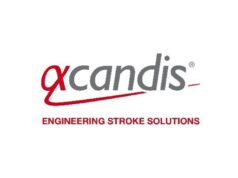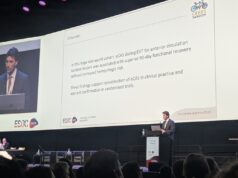
In December 2021, University Hospital Basel (Basel, Switzerland) enrolled the first patient worldwide in the DISTAL study—a multicentre randomised controlled trial (RCT) evaluating the clinical efficacy of endovascular therapy (EVT) in acute ischaemic stroke patients with an isolated medium vessel occlusion (MeVO)*. More specifically, its primary objective will be to determine whether these patients experience superior long-term functional outcomes, measured via the modified Rankin Scale (mRS) at 90 days, when treated with EVT plus best medical therapy (BMT) versus BMT alone. According to the DISTAL core team, this international, pragmatic, 1:1 randomised trial with blinded-endpoint assessment aims to provide conclusive, real-world information on the efficacy and safety of EVT in MeVO stroke patients. Here, the team—consisting of principal investigators Marios Psychogios and Urs Fischer, project manager Luzia Balmer and senior scientific expert Alex Brehm (all University Hospital Basel)—discuss finer details and broader ambitions of the study.
Have EVT outcomes for other indications, such as large vessel occlusion (LVO) stroke, been subject to more clinical research than MeVO thus far—and why is this?
Absolutely, however it could also be seen as the natural evolution of establishing evidence for the endovascular treatment approach. Back in 2010, we were all convinced that EVT is the gamechanger for stroke patients with an LVO, but then the so-called “unhappy triad” was published in 2013: three RCTs showing no beneficial effect of EVT on clinical outcomes.
This put us back to square one. We had to learn the lessons from these trials and refine the techniques as well as the target population. Largest effect sizes were observed in patients with LVO strokes, which were then chosen as the target population for further pivotal trials. Consequently, the trials proved an overwhelming treatment effect of EVT on the clinical outcome of these selected patients. Now, for patients with MeVOs, we are in the same situation we found ourselves in a decade ago—we hypothesise that it might be beneficial to treat these patients endovascularly, but randomised evidence is lacking. Therefore, we started the DISTAL trial.
What is the current unmet need with regard to MeVO stroke and, as such, why is it especially important to shed more light on EVT outcomes in these patients?
As of now, the only evidence-based treatment for MeVO stroke patients is intravenous thrombolysis. However, we all know that intravenous thrombolysis has a rather narrow time window and a rapidly decreasing efficacy, as well as relevant contraindications, leaving many patients with a MeVO stroke without an effective treatment option. The outcome of a MeVO stroke can be devastating and may lead to lifelong disability or death. It is therefore of utmost importance to establish an effective treatment option for these patients.
Why was mRS selected as the primary outcome measure in the DISTAL trial? And, what are the study’s key secondary endpoints?
Despite its limitations, the mRS is currently the most established outcome parameter in stroke trials and its use is also supported by stroke patients. We consulted the largest patient organisation for stroke survivors in Switzerland (Fragile Suisse) and they acknowledged that achieving a good functional outcome, measured with the mRS, is of very high relevance to patients in the setting of MeVO. However, we are aware that the mRS does not capture minor clinical deficits, which may have a major impact on the quality of life for individual patients. The change in clinical deficit from baseline to follow-up, measured with the National Institute of Health Stroke Scale (NIHSS) score, would eventually have been more sensitive to capture stroke-related deficits, but the NIHSS is not a patient-centred outcome.
Secondary endpoints, however, include the change in NIHSS from baseline to follow-up, quality of life, cognitive function, all-cause mortality, percentage of brain saved on imaging, and place of residence one year after the stroke. The latter of these was a suggestion from Fragile Suisse, as they pointed out that returning home—and staying home—is of utmost importance to patients. Cognitive function, meanwhile, was chosen as a secondary endpoint because it is very sensitive to subtle differences.
We will use the percentage of brain saved as the main imaging outcome since it is a direct image-based measurement of the treatment effect. We have opted against using final infarct volume as an imaging outcome parameter due to the heterogeneity of the sizes of the territories supplied by different MeVOs. Since the percentage of brain saved is derived from the final infarct volume, it is reasonable to assume that, as the final infarct volume, it can be used as a surrogate for functional outcome. Multiple studies have shown a strong correlation between final infarct volume and functional outcome. And, in patients with occlusions of the posterior cerebral artery especially, this outcome will be of high value, since it is known that clinical assessment tools such as mRS and NIHSS underestimate clinically relevant sequelae of these occlusions.
What are the safety endpoints in the study, and how will you minimise the potential risks and complications associated with EVT?
The main safety endpoint will be the occurrence of symptomatic intracranial haemorrhage after randomisation. Retrospective studies have shown similar rates of symptomatic intracranial haemorrhage in patients treated either with EVT or BMT only. In our experience, using dedicated materials and techniques significantly reduces the risk of complications and downsides of EVT. As with the SAVE (Stent retriever-assisted vacuum-locked extraction) technique for LVOs before, we are now in the process of publishing refined techniques as video cases, in dedicated journals, and on our One Stop In Stroke YouTube channel. Additionally, discussions about materials and techniques are an important part of our site screening and initiation visits as we strive to achieve the highest technical standards within the trial.
Which revascularisation devices will be used in the DISTAL study?
DISTAL is a pragmatic trial and does not restrict the use of devices. Commercially available CE-certified stent retrievers, aspiration catheters, balloon guide catheters and other devices are therefore freely chosen by the treating physician based on their clinical judgment and expertise, as the trial is assessing the procedure, and not a medical device.
Regarding the trial’s margin for superiority, how much better will EVT plus BMT have to be than BMT alone to be deemed a success?
The primary outcome of mRS at 90 days will be evaluated using a shift analysis. We based our sample size calculation on recently published data regarding the outcome of MeVO patients treated with BMT only—which estimated that 67% regained functional independence at day 90. Although other published data and our own analysis of the Swiss Stroke Registry suggest lower rates of functional independence (55% in the Swiss Stroke Registry), we used this finding as a conservative estimate. Based on this rate of functional independence among MeVO patients, the margin in the trial is 14%, meaning that 81% of patients in the EVT group should be functionally independent at 90 days. However, in the instance that the control group has worse outcomes, lower margins would lead to the trial being considered a success. This approach was chosen based on the observed results in previous basilar artery occlusion trials.
Having recently initiated the DISTAL study, what are your future goals in terms of timelines?
At time of writing, 14 patients have been randomised in the trial. Our main goal is to initiate as many sites as possible within the next few months, and we plan to enrol a total of 526 patients across ≥40 global sites over a period of 36 months. In Switzerland, we already have five recruiting sites, and we have obtained ethical approval to expand into Germany this year. Ethical approval in Belgium, Spain, Finland, Israel and Portugal is pending as well. Our aim is to finish enrolment at the end of 2024 and present our results in mid-2025.
What impact could this trial’s results have within the stroke care field?
If the trial shows superiority of EVT, it could have an impact on future guidelines and clinical practice. As with the LVO trials of 2015, there are multiple MeVO trials starting now, so we can expect good evidence within the next few years. EVT could eventually become the standard of care for MeVO patients, improving their quality of life and reducing the burden of stroke in these patients.
Furthermore, individual patient data meta-analyses will be performed with other, similar trials evaluating the efficacy of EVT in MeVO patients—for example, the DISCOUNT trial in France and the ESCAPE-MeVO trial in Canada. We intend to perform individual patient data meta-analyses of all published trials, and we think that combining our results with such studies, which are also using mRS as their primary endpoint, will help to corroborate the evidence for EVT in MeVO patients. This would also allow us to perform subgroup analyses for different patient cohorts i.e. type and site of vessel occlusions, different time windows, and other important baseline factors. Furthermore, the effect of different technical approaches and the safety of the used devices can be evaluated with this pooled dataset.
*Defined as an isolated occlusion of the co- or non-dominant M2, M3 or M4 segment of the middle cerebral artery, the A1, A2 or A3 of the anterior cerebral artery, the P1 or P2 segment of the posterior cerebral artery.












